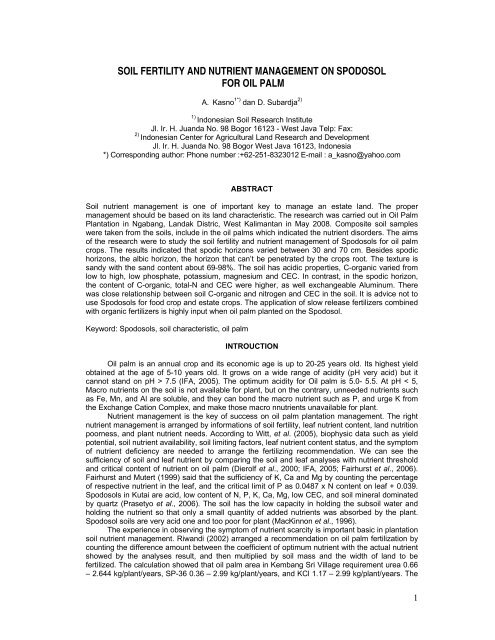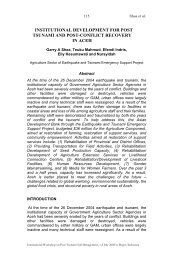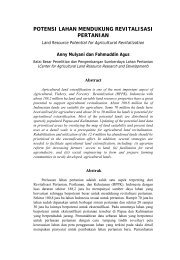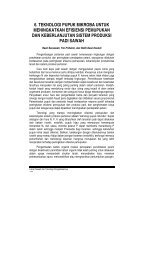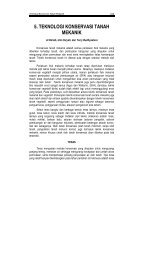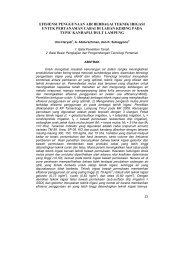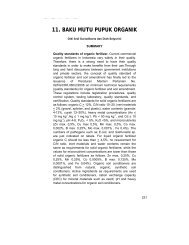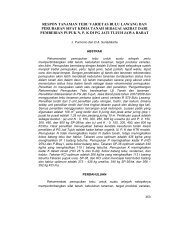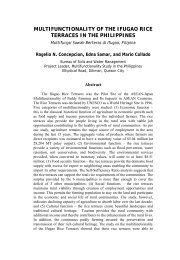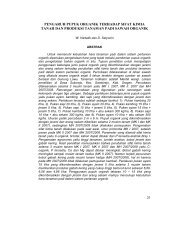soil fertility and nutrient management on spodosol for oil palm
soil fertility and nutrient management on spodosol for oil palm
soil fertility and nutrient management on spodosol for oil palm
You also want an ePaper? Increase the reach of your titles
YUMPU automatically turns print PDFs into web optimized ePapers that Google loves.
SOIL FERTILITY AND NUTRIENT MANAGEMENT ON SPODOSOL<br />
FOR OIL PALM<br />
A. Kasno 1*) dan D. Subardja 2)<br />
1) Ind<strong>on</strong>esian S<strong>oil</strong> Research Institute<br />
Jl. Ir. H. Ju<str<strong>on</strong>g>and</str<strong>on</strong>g>a No. 98 Bogor 16123 - West Java Telp: Fax:<br />
2) Ind<strong>on</strong>esian Center <strong>for</strong> Agricultural L<str<strong>on</strong>g>and</str<strong>on</strong>g> Research <str<strong>on</strong>g>and</str<strong>on</strong>g> Development<br />
Jl. Ir. H. Ju<str<strong>on</strong>g>and</str<strong>on</strong>g>a No. 98 Bogor West Java 16123, Ind<strong>on</strong>esia<br />
*) Corresp<strong>on</strong>ding author: Ph<strong>on</strong>e number :+62-251-8323012 E-mail : a_kasno@yahoo.com<br />
ABSTRACT<br />
S<strong>oil</strong> <str<strong>on</strong>g>nutrient</str<strong>on</strong>g> <str<strong>on</strong>g>management</str<strong>on</strong>g> is <strong>on</strong>e of important key to manage an estate l<str<strong>on</strong>g>and</str<strong>on</strong>g>. The proper<br />
<str<strong>on</strong>g>management</str<strong>on</strong>g> should be based <strong>on</strong> its l<str<strong>on</strong>g>and</str<strong>on</strong>g> characteristic. The research was carried out in Oil Palm<br />
Plantati<strong>on</strong> in Ngabang, L<str<strong>on</strong>g>and</str<strong>on</strong>g>ak Distric, West Kalimantan in May 2008. Composite <str<strong>on</strong>g>s<strong>oil</strong></str<strong>on</strong>g> samples<br />
were taken from the <str<strong>on</strong>g>s<strong>oil</strong></str<strong>on</strong>g>s, include in the <strong>oil</strong> <strong>palm</strong>s which indicated the <str<strong>on</strong>g>nutrient</str<strong>on</strong>g> disorders. The aims<br />
of the research were to study the <str<strong>on</strong>g>s<strong>oil</strong></str<strong>on</strong>g> <str<strong>on</strong>g>fertility</str<strong>on</strong>g> <str<strong>on</strong>g>and</str<strong>on</strong>g> <str<strong>on</strong>g>nutrient</str<strong>on</strong>g> <str<strong>on</strong>g>management</str<strong>on</strong>g> of Spodosols <strong>for</strong> <strong>oil</strong> <strong>palm</strong><br />
crops. The results indicated that spodic horiz<strong>on</strong>s varied between 30 <str<strong>on</strong>g>and</str<strong>on</strong>g> 70 cm. Besides spodic<br />
horiz<strong>on</strong>s, the albic horiz<strong>on</strong>, the horiz<strong>on</strong> that can’t be penetrated by the crops root. The texture is<br />
s<str<strong>on</strong>g>and</str<strong>on</strong>g>y with the s<str<strong>on</strong>g>and</str<strong>on</strong>g> c<strong>on</strong>tent about 69-98%. The <str<strong>on</strong>g>s<strong>oil</strong></str<strong>on</strong>g> has acidic properties, C-organic varied from<br />
low to high, low phosphate, potassium, magnesium <str<strong>on</strong>g>and</str<strong>on</strong>g> CEC. In c<strong>on</strong>trast, in the spodic horiz<strong>on</strong>,<br />
the c<strong>on</strong>tent of C-organic, total-N <str<strong>on</strong>g>and</str<strong>on</strong>g> CEC were higher, as well exchangeable Aluminum. There<br />
was close relati<strong>on</strong>ship between <str<strong>on</strong>g>s<strong>oil</strong></str<strong>on</strong>g> C-organic <str<strong>on</strong>g>and</str<strong>on</strong>g> nitrogen <str<strong>on</strong>g>and</str<strong>on</strong>g> CEC in the <str<strong>on</strong>g>s<strong>oil</strong></str<strong>on</strong>g>. It is advice not to<br />
use Spodosols <strong>for</strong> food crop <str<strong>on</strong>g>and</str<strong>on</strong>g> estate crops. The applicati<strong>on</strong> of slow release fertilizers combined<br />
with organic fertilizers is highly input when <strong>oil</strong> <strong>palm</strong> planted <strong>on</strong> the Spodosol.<br />
Keyword: Spodosols, <str<strong>on</strong>g>s<strong>oil</strong></str<strong>on</strong>g> characteristic, <strong>oil</strong> <strong>palm</strong><br />
INTROUCTION<br />
Oil <strong>palm</strong> is an annual crop <str<strong>on</strong>g>and</str<strong>on</strong>g> its ec<strong>on</strong>omic age is up to 20-25 years old. Its highest yield<br />
obtained at the age of 5-10 years old. It grows <strong>on</strong> a wide range of acidity (pH very acid) but it<br />
cannot st<str<strong>on</strong>g>and</str<strong>on</strong>g> <strong>on</strong> pH > 7.5 (IFA, 2005). The optimum acidity <strong>for</strong> Oil <strong>palm</strong> is 5.0- 5.5. At pH < 5,<br />
Macro <str<strong>on</strong>g>nutrient</str<strong>on</strong>g>s <strong>on</strong> the <str<strong>on</strong>g>s<strong>oil</strong></str<strong>on</strong>g> is not available <strong>for</strong> plant, but <strong>on</strong> the c<strong>on</strong>trary, unneeded <str<strong>on</strong>g>nutrient</str<strong>on</strong>g>s such<br />
as Fe, Mn, <str<strong>on</strong>g>and</str<strong>on</strong>g> Al are soluble, <str<strong>on</strong>g>and</str<strong>on</strong>g> they can b<strong>on</strong>d the macro <str<strong>on</strong>g>nutrient</str<strong>on</strong>g> such as P, <str<strong>on</strong>g>and</str<strong>on</strong>g> urge K from<br />
the Exchange Cati<strong>on</strong> Complex, <str<strong>on</strong>g>and</str<strong>on</strong>g> make those macro n<str<strong>on</strong>g>nutrient</str<strong>on</strong>g>s unavailable <strong>for</strong> plant.<br />
Nutrient <str<strong>on</strong>g>management</str<strong>on</strong>g> is the key of success <strong>on</strong> <strong>oil</strong> <strong>palm</strong> plantati<strong>on</strong> <str<strong>on</strong>g>management</str<strong>on</strong>g>. The right<br />
<str<strong>on</strong>g>nutrient</str<strong>on</strong>g> <str<strong>on</strong>g>management</str<strong>on</strong>g> is arranged by in<strong>for</strong>mati<strong>on</strong>s of <str<strong>on</strong>g>s<strong>oil</strong></str<strong>on</strong>g> <str<strong>on</strong>g>fertility</str<strong>on</strong>g>, leaf <str<strong>on</strong>g>nutrient</str<strong>on</strong>g> c<strong>on</strong>tent, l<str<strong>on</strong>g>and</str<strong>on</strong>g> nutriti<strong>on</strong><br />
poorness, <str<strong>on</strong>g>and</str<strong>on</strong>g> plant <str<strong>on</strong>g>nutrient</str<strong>on</strong>g> needs. According to Witt, et al. (2005), biophysic data such as yield<br />
potential, <str<strong>on</strong>g>s<strong>oil</strong></str<strong>on</strong>g> <str<strong>on</strong>g>nutrient</str<strong>on</strong>g> availability, <str<strong>on</strong>g>s<strong>oil</strong></str<strong>on</strong>g> limiting factors, leaf <str<strong>on</strong>g>nutrient</str<strong>on</strong>g> c<strong>on</strong>tent status, <str<strong>on</strong>g>and</str<strong>on</strong>g> the symptom<br />
of <str<strong>on</strong>g>nutrient</str<strong>on</strong>g> deficiency are needed to arrange the fertilizing recommendati<strong>on</strong>. We can see the<br />
sufficiency of <str<strong>on</strong>g>s<strong>oil</strong></str<strong>on</strong>g> <str<strong>on</strong>g>and</str<strong>on</strong>g> leaf <str<strong>on</strong>g>nutrient</str<strong>on</strong>g> by comparing the <str<strong>on</strong>g>s<strong>oil</strong></str<strong>on</strong>g> <str<strong>on</strong>g>and</str<strong>on</strong>g> leaf analyses with <str<strong>on</strong>g>nutrient</str<strong>on</strong>g> threshold<br />
<str<strong>on</strong>g>and</str<strong>on</strong>g> critical c<strong>on</strong>tent of <str<strong>on</strong>g>nutrient</str<strong>on</strong>g> <strong>on</strong> <strong>oil</strong> <strong>palm</strong> (Dierolf et al., 2000; IFA, 2005; Fairhurst et al., 2006).<br />
Fairhurst <str<strong>on</strong>g>and</str<strong>on</strong>g> Mutert (1999) said that the sufficiency of K, Ca <str<strong>on</strong>g>and</str<strong>on</strong>g> Mg by counting the percentage<br />
of respective <str<strong>on</strong>g>nutrient</str<strong>on</strong>g> in the leaf, <str<strong>on</strong>g>and</str<strong>on</strong>g> the critical limit of P as 0.0487 x N c<strong>on</strong>tent <strong>on</strong> leaf + 0.039.<br />
Spodosols in Kutai are acid, low c<strong>on</strong>tent of N, P, K, Ca, Mg, low CEC, <str<strong>on</strong>g>and</str<strong>on</strong>g> <str<strong>on</strong>g>s<strong>oil</strong></str<strong>on</strong>g> mineral dominated<br />
by quartz (Prasetyo et al., 2006). The <str<strong>on</strong>g>s<strong>oil</strong></str<strong>on</strong>g> has the low capacity in holding the sub<str<strong>on</strong>g>s<strong>oil</strong></str<strong>on</strong>g> water <str<strong>on</strong>g>and</str<strong>on</strong>g><br />
holding the <str<strong>on</strong>g>nutrient</str<strong>on</strong>g> so that <strong>on</strong>ly a small quantity of added <str<strong>on</strong>g>nutrient</str<strong>on</strong>g>s was absorbed by the plant.<br />
Spodosol <str<strong>on</strong>g>s<strong>oil</strong></str<strong>on</strong>g>s are very acid <strong>on</strong>e <str<strong>on</strong>g>and</str<strong>on</strong>g> too poor <strong>for</strong> plant (MacKinn<strong>on</strong> et al., 1996).<br />
The experience in observing the symptom of <str<strong>on</strong>g>nutrient</str<strong>on</strong>g> scarcity is important basic in plantati<strong>on</strong><br />
<str<strong>on</strong>g>s<strong>oil</strong></str<strong>on</strong>g> <str<strong>on</strong>g>nutrient</str<strong>on</strong>g> <str<strong>on</strong>g>management</str<strong>on</strong>g>. Riw<str<strong>on</strong>g>and</str<strong>on</strong>g>i (2002) arranged a recommendati<strong>on</strong> <strong>on</strong> <strong>oil</strong> <strong>palm</strong> fertilizati<strong>on</strong> by<br />
counting the difference amount between the coefficient of optimum <str<strong>on</strong>g>nutrient</str<strong>on</strong>g> with the actual <str<strong>on</strong>g>nutrient</str<strong>on</strong>g><br />
showed by the analyses result, <str<strong>on</strong>g>and</str<strong>on</strong>g> then multiplied by <str<strong>on</strong>g>s<strong>oil</strong></str<strong>on</strong>g> mass <str<strong>on</strong>g>and</str<strong>on</strong>g> the width of l<str<strong>on</strong>g>and</str<strong>on</strong>g> to be<br />
fertilized. The calculati<strong>on</strong> showed that <strong>oil</strong> <strong>palm</strong> area in Kembang Sri Village requirement urea 0.66<br />
– 2.644 kg/plant/years, SP-36 0.36 – 2.99 kg/plant/years, <str<strong>on</strong>g>and</str<strong>on</strong>g> KCl 1.17 – 2.99 kg/plant/years. The<br />
1
next fertilizing recommendati<strong>on</strong> <strong>for</strong> next seas<strong>on</strong> will be corrected using the result of leaf <str<strong>on</strong>g>nutrient</str<strong>on</strong>g><br />
c<strong>on</strong>tent analyses.<br />
Balance ffertilizati<strong>on</strong> <strong>on</strong> Melanud<str<strong>on</strong>g>and</str<strong>on</strong>g> in equator can increase the <strong>oil</strong> <strong>palm</strong> yield (Mite et al.,<br />
1999). Fertilizati<strong>on</strong> efficiency is influenced by the amount of <str<strong>on</strong>g>nutrient</str<strong>on</strong>g> to be added <str<strong>on</strong>g>and</str<strong>on</strong>g> the method<br />
of fertilizing. Most of the field fertilizing method is by spreading the fertilizer over the ground/<str<strong>on</strong>g>s<strong>oil</strong></str<strong>on</strong>g><br />
surface. So the fertilizer is <strong>on</strong> high risk to be transported by the erroti<strong>on</strong> process, run off <str<strong>on</strong>g>and</str<strong>on</strong>g><br />
evaporati<strong>on</strong>.<br />
The aim of this paper were to study the <str<strong>on</strong>g>s<strong>oil</strong></str<strong>on</strong>g> characteristic <strong>on</strong> Spodosols <str<strong>on</strong>g>and</str<strong>on</strong>g> the l<str<strong>on</strong>g>and</str<strong>on</strong>g><br />
<str<strong>on</strong>g>nutrient</str<strong>on</strong>g> <str<strong>on</strong>g>management</str<strong>on</strong>g> of <strong>oil</strong> <strong>palm</strong> plantati<strong>on</strong> in Ngabang, L<str<strong>on</strong>g>and</str<strong>on</strong>g>ak District, West Kalimantan<br />
Province.<br />
MATERIAL AND METHODS<br />
This study was c<strong>on</strong>ducted in Spodosols <str<strong>on</strong>g>s<strong>oil</strong></str<strong>on</strong>g>, <strong>oil</strong> <strong>palm</strong> plantati<strong>on</strong> at Ngabang, L<str<strong>on</strong>g>and</str<strong>on</strong>g>ak District,<br />
West Kalimantan Province <strong>on</strong> mid May 2008, by observing the symptom of <str<strong>on</strong>g>nutrient</str<strong>on</strong>g> deficiency <strong>on</strong><br />
<strong>oil</strong> <strong>palm</strong> plant <str<strong>on</strong>g>and</str<strong>on</strong>g> <strong>on</strong> some plant indicators of <str<strong>on</strong>g>s<strong>oil</strong></str<strong>on</strong>g> <str<strong>on</strong>g>fertility</str<strong>on</strong>g>, <str<strong>on</strong>g>and</str<strong>on</strong>g> also by observing the <strong>oil</strong> <strong>palm</strong><br />
growth of some <str<strong>on</strong>g>s<strong>oil</strong></str<strong>on</strong>g>, <str<strong>on</strong>g>and</str<strong>on</strong>g> taking samples of <str<strong>on</strong>g>s<strong>oil</strong></str<strong>on</strong>g> <str<strong>on</strong>g>and</str<strong>on</strong>g> leaf of 9 young <strong>oil</strong> <strong>palm</strong> plants ( 30%.<br />
RESULTS AND DISCUSSION<br />
S<strong>oil</strong> Chemical Characteristic<br />
S<strong>oil</strong> structuce of Spodosols is s<str<strong>on</strong>g>and</str<strong>on</strong>g>y loos from the upper solum surface up to the hard<br />
spodic or albic horiz<strong>on</strong>. The s<str<strong>on</strong>g>and</str<strong>on</strong>g> c<strong>on</strong>tent was between 69 – 98% (Table 1). Loos <str<strong>on</strong>g>and</str<strong>on</strong>g> s<str<strong>on</strong>g>and</str<strong>on</strong>g>y<br />
structure indicate the unability to hold water, <str<strong>on</strong>g>s<strong>oil</strong></str<strong>on</strong>g> <str<strong>on</strong>g>nutrient</str<strong>on</strong>g> nor the adding <str<strong>on</strong>g>nutrient</str<strong>on</strong>g>s. The soluble<br />
<str<strong>on</strong>g>nutrient</str<strong>on</strong>g>s will be leached immidiately <str<strong>on</strong>g>and</str<strong>on</strong>g> then accumulated over the spodic or albic layer <str<strong>on</strong>g>and</str<strong>on</strong>g> then<br />
transported by lateral flow, <str<strong>on</strong>g>and</str<strong>on</strong>g> flowing into the weaker spots of caesars. So that the added<br />
<str<strong>on</strong>g>nutrient</str<strong>on</strong>g> will be lost in a short time <str<strong>on</strong>g>and</str<strong>on</strong>g> the plant cannot take the advantages of it. Most of the<br />
existing <strong>oil</strong> <strong>palm</strong> plant showed the symptom of N, P, K, Mg, <str<strong>on</strong>g>and</str<strong>on</strong>g> B deficiencies.<br />
Spodosols are characteristically very acid (pH 3,5) to moderately acid (pH 4,2). Oil Palm<br />
plant can grow well <strong>on</strong> low pH. The low pH <str<strong>on</strong>g>s<strong>oil</strong></str<strong>on</strong>g> c<strong>on</strong>diti<strong>on</strong>s make the macro <str<strong>on</strong>g>nutrient</str<strong>on</strong>g>s unavailable<br />
<strong>for</strong> the plant growth. Under the circumstances there is fixati<strong>on</strong> of P <str<strong>on</strong>g>nutrient</str<strong>on</strong>g> made by Al, Fe <str<strong>on</strong>g>and</str<strong>on</strong>g> Mn<br />
hydroxide, <str<strong>on</strong>g>and</str<strong>on</strong>g> K <str<strong>on</strong>g>nutrient</str<strong>on</strong>g> is exhorted out by Al 3+ <str<strong>on</strong>g>and</str<strong>on</strong>g> H + from adsorpti<strong>on</strong> complex in mass manner.<br />
In that case, the sec<strong>on</strong>dary macro <str<strong>on</strong>g>nutrient</str<strong>on</strong>g> (Ca <str<strong>on</strong>g>and</str<strong>on</strong>g> Mg) were unavailable <strong>for</strong> the plant growth.<br />
Lime or dolomite can be added to provide Ca <str<strong>on</strong>g>and</str<strong>on</strong>g> Mg <str<strong>on</strong>g>and</str<strong>on</strong>g> increase the pH.<br />
S<strong>oil</strong> with loose s<str<strong>on</strong>g>and</str<strong>on</strong>g> texture <str<strong>on</strong>g>and</str<strong>on</strong>g> low C-organic c<strong>on</strong>tent will get dry immediately <strong>on</strong> the dry<br />
2
seas<strong>on</strong>, <strong>for</strong> such <str<strong>on</strong>g>s<strong>oil</strong></str<strong>on</strong>g> cannot hold the water. This c<strong>on</strong>diti<strong>on</strong> makes the water <str<strong>on</strong>g>and</str<strong>on</strong>g> <str<strong>on</strong>g>nutrient</str<strong>on</strong>g>s<br />
evaporated quickly. Water is an important media <strong>for</strong> <str<strong>on</strong>g>nutrient</str<strong>on</strong>g> reacti<strong>on</strong>. Lacking the water will disturb<br />
the biochemical reacti<strong>on</strong> process <str<strong>on</strong>g>and</str<strong>on</strong>g> it means that the fertilizer will not quickly available <strong>for</strong> plant.<br />
In c<strong>on</strong>sequence we will see the plant with the symptoms of some <str<strong>on</strong>g>nutrient</str<strong>on</strong>g>s deficiency in the dry<br />
<str<strong>on</strong>g>s<strong>oil</strong></str<strong>on</strong>g>s. It is not because of lacking <str<strong>on</strong>g>nutrient</str<strong>on</strong>g>s in the <str<strong>on</strong>g>s<strong>oil</strong></str<strong>on</strong>g>s but the dry <str<strong>on</strong>g>s<strong>oil</strong></str<strong>on</strong>g> made the reacti<strong>on</strong> process<br />
does not running well.<br />
Spodosol <str<strong>on</strong>g>s<strong>oil</strong></str<strong>on</strong>g>s have the very low to very high level of C-organic c<strong>on</strong>tent. The darker color of<br />
the <str<strong>on</strong>g>s<strong>oil</strong></str<strong>on</strong>g> surface (unerroded organic matter) means the higher c<strong>on</strong>tent of C-organic, <str<strong>on</strong>g>and</str<strong>on</strong>g> the paler<br />
color of the <str<strong>on</strong>g>s<strong>oil</strong></str<strong>on</strong>g> surface (where spodic horiz<strong>on</strong> getting out to the <str<strong>on</strong>g>s<strong>oil</strong></str<strong>on</strong>g> surface) means that the <str<strong>on</strong>g>s<strong>oil</strong></str<strong>on</strong>g><br />
has a lower c<strong>on</strong>tent of C-organic. Thus we can say that leaching process will run fast <strong>on</strong> the <str<strong>on</strong>g>s<strong>oil</strong></str<strong>on</strong>g><br />
with loose s<str<strong>on</strong>g>and</str<strong>on</strong>g> texture <str<strong>on</strong>g>and</str<strong>on</strong>g> low C-organic c<strong>on</strong>tent. The C-organic role can be seen clearly at the<br />
growth of <strong>oil</strong> <strong>palm</strong> planted near the log p<strong>on</strong>d (greener <str<strong>on</strong>g>and</str<strong>on</strong>g> healthier than others).<br />
Table 1. Texture, pH <str<strong>on</strong>g>and</str<strong>on</strong>g> C-organic c<strong>on</strong>tent <strong>on</strong> Spodosol <str<strong>on</strong>g>s<strong>oil</strong></str<strong>on</strong>g><br />
Code of locati<strong>on</strong><br />
S<str<strong>on</strong>g>and</str<strong>on</strong>g><br />
Texture (%)<br />
Silt Clay H2O<br />
pH<br />
1N KCl<br />
C organic<br />
%<br />
AL01 79 20 1 4.0 3.0 2.95<br />
AL09 94 6 0 3.8 3.3 0.71<br />
AL10 92 8 0 4.0 3.2 2.10<br />
AL14 69 31 0 4.2 3.6 2.91<br />
AL19 85 12 3 3.9 3.1 2.05<br />
AL22 89 9 2 4.4 4.0 1.34<br />
DS01 98 2 0 4.1 3.1 1.97<br />
DS02 92 5 3 3.5 3.0 1.77<br />
DS03 95 3 1 3.5 3.2 1.10<br />
RR03 91 2 7 3.8 3.1 3.60<br />
RR08 93 5 2 4.3 4.2 0.09<br />
AL21 98 2 0 4.0 3.1 1.67<br />
DS04 96 4 0 3.9 3.0 3.54<br />
The clay c<strong>on</strong>tent is getting higher <strong>on</strong> the compact/spodic layer, <str<strong>on</strong>g>and</str<strong>on</strong>g> get <strong>on</strong> increasing in the<br />
lower layer (Table 2). The c<strong>on</strong>tent of C-organic, total-N, CEC <str<strong>on</strong>g>and</str<strong>on</strong>g> Al 3+ are higher in the spodic<br />
layer than the top<str<strong>on</strong>g>s<strong>oil</strong></str<strong>on</strong>g> layer. Just like the <str<strong>on</strong>g>s<strong>oil</strong></str<strong>on</strong>g> texture case, the rapid <str<strong>on</strong>g>nutrient</str<strong>on</strong>g> leaching causes<br />
accumulati<strong>on</strong>. Those facts proof that there was a leaching process of clay, C-organic, N <str<strong>on</strong>g>and</str<strong>on</strong>g> Al<br />
<str<strong>on</strong>g>nutrient</str<strong>on</strong>g> from the top<str<strong>on</strong>g>s<strong>oil</strong></str<strong>on</strong>g> layer. The hard spodic layer is <strong>for</strong>med by the reacti<strong>on</strong> between C-organic<br />
<str<strong>on</strong>g>and</str<strong>on</strong>g> Al, Fe, <str<strong>on</strong>g>and</str<strong>on</strong>g> Mn elements.<br />
Table 2. The result of physical <str<strong>on</strong>g>and</str<strong>on</strong>g> chemical <str<strong>on</strong>g>s<strong>oil</strong></str<strong>on</strong>g> analysis characteristic <strong>on</strong> <str<strong>on</strong>g>s<strong>oil</strong></str<strong>on</strong>g> profile in Spodosol<br />
Profile code<br />
KTK<br />
S<str<strong>on</strong>g>and</str<strong>on</strong>g> Silt Clay pH C orgnaic Total N<br />
CEC<br />
H2O<br />
...............%.............. ........%....... me/100 g<br />
DS 01/1 98 2 0 4.1 1.97 0.13 2.42 0.12<br />
DS 01/2 97 1 2 4.2 0.19 0.02 0.40 0.00<br />
DS 01/3 - - - 3.5 11.05 0.43 20.26 8.03<br />
DS 01/4 68 0 32 4.1 2.77 0.23 10.67 2.60<br />
DS 01/5 26 5 69 3.7 1.63 0.13 10.45 3.23<br />
The roots of <strong>oil</strong> <strong>palm</strong> planted <strong>on</strong> the <str<strong>on</strong>g>s<strong>oil</strong></str<strong>on</strong>g> having the spodic layers cannot freely develop <strong>for</strong><br />
they cannot go through the hard layers (Fig. 1). C<strong>on</strong>sequently the roots cannot adsorb the<br />
<str<strong>on</strong>g>nutrient</str<strong>on</strong>g>s <str<strong>on</strong>g>and</str<strong>on</strong>g> there will be the symptoms of <str<strong>on</strong>g>nutrient</str<strong>on</strong>g> deficiency.<br />
Al 3+<br />
3
Figure 1. Oil Palm growth <strong>on</strong> the<br />
upper spodic layer<br />
The total-N c<strong>on</strong>tent ranges from “very low” to “very high”, but mostly “low”. The high total-N<br />
c<strong>on</strong>tent occurs where C-organic c<strong>on</strong>tent is high. While CEC, P <str<strong>on</strong>g>and</str<strong>on</strong>g> K <str<strong>on</strong>g>nutrient</str<strong>on</strong>g> c<strong>on</strong>tent of Spodosol<br />
<str<strong>on</strong>g>s<strong>oil</strong></str<strong>on</strong>g>s are very low. The CEC is very low, it means that the <str<strong>on</strong>g>s<strong>oil</strong></str<strong>on</strong>g> cannot hold the <str<strong>on</strong>g>nutrient</str<strong>on</strong>g> added, or in<br />
other words, the fertilizer was leached <str<strong>on</strong>g>and</str<strong>on</strong>g> transported by the lateral flow.<br />
There is a close relati<strong>on</strong>ship between N <str<strong>on</strong>g>and</str<strong>on</strong>g> C-organic c<strong>on</strong>tent in the <str<strong>on</strong>g>s<strong>oil</strong></str<strong>on</strong>g>. The equati<strong>on</strong> is r 2<br />
= 0,98 (Fig. 2). The N c<strong>on</strong>tent in the <str<strong>on</strong>g>s<strong>oil</strong></str<strong>on</strong>g> will increase by suppressing decompositi<strong>on</strong>, leaching, <str<strong>on</strong>g>and</str<strong>on</strong>g><br />
C-organic losing (through the runoff <str<strong>on</strong>g>and</str<strong>on</strong>g> erosi<strong>on</strong>), <str<strong>on</strong>g>and</str<strong>on</strong>g> planting l<str<strong>on</strong>g>and</str<strong>on</strong>g> cover crop <str<strong>on</strong>g>and</str<strong>on</strong>g> managing the<br />
water drainage could per<strong>for</strong>m such ef<strong>for</strong>t. There is also a close relati<strong>on</strong>ship between <str<strong>on</strong>g>s<strong>oil</strong></str<strong>on</strong>g> C-<br />
Organic c<strong>on</strong>tent with CEC (Fig.3). Thus, in other words, we can improve the <str<strong>on</strong>g>s<strong>oil</strong></str<strong>on</strong>g> <str<strong>on</strong>g>fertility</str<strong>on</strong>g> by<br />
managing the <str<strong>on</strong>g>s<strong>oil</strong></str<strong>on</strong>g> organic matter.<br />
Table 3. The result of chemical Spodolsol <str<strong>on</strong>g>s<strong>oil</strong></str<strong>on</strong>g> analysis <strong>on</strong> <strong>oil</strong> <strong>palm</strong> plantati<strong>on</strong><br />
Locati<strong>on</strong> code<br />
Total N<br />
%<br />
Total P<br />
mg/100 g<br />
Available P<br />
mg P/kg<br />
Exch.-K Ech.-Mg<br />
cmolc/kg<br />
CEC<br />
AL01 0.23 T 4.4 SR 1.70 SR 0.07 SR 0.22 R 5.26 SR<br />
AL09 0.07 SR 4.4 SR 2.01 SR 0.02 SR 0.22 R 1.99 SR<br />
AL10 0.18 S 13.1 SR 1.53 SR 0.02 SR 0.41 ST 5.38 SR<br />
AL14 0.23 S 8.7 SR 1.96 SR 0.03 SR 0.51 ST 6.68 SR<br />
AL19 0.16 S 13.1 SR 2.93 SR 0.02 SR 0.31 ST 5.45 SR<br />
AL22 0.11 R 4.4 SR 1.22 SR 0.02 SR 0.22 S 1.75 SR<br />
DS01 0.13 R 4.4 SR 1.27 SR 0.06 SR 0.19 SR 2.42 SR<br />
DS02 0.15 S 13.1 SR 0.92 SR 0.06 SR 0.16 SR 2.68 SR<br />
DS03 0.09 R 8.7 SR 0.79 SR 0.00 SR 0.12 SR 1.83 SR<br />
RR03 0.27 ST 17.5 SR 3.23 SR 0.03 SR 0.52 ST 4.84 SR<br />
RR08 0.01 SR 13.1 SR 0.44 SR 0.00 SR 0.09 SR 0.47 SR<br />
AL21 0.13 R 8.7 SR 2.05 SR 0.03 SR 0.13 SR 3.09 SR<br />
DS04 0.27 ST 13.1 SR 2.05 SR 0.03 SR 0.56 ST 6.34 SR<br />
Keterangan: SR = sangat rendah, R = rendah, S = sedanga, T = tinggi, ST = sangat tinggi, Ech =<br />
Exchangeable<br />
4
Figure 2. Relati<strong>on</strong> between <str<strong>on</strong>g>s<strong>oil</strong></str<strong>on</strong>g> organic C <str<strong>on</strong>g>and</str<strong>on</strong>g> total N <strong>on</strong> Spodosol<br />
Figure 3. Relati<strong>on</strong> between <str<strong>on</strong>g>s<strong>oil</strong></str<strong>on</strong>g> organic C <str<strong>on</strong>g>and</str<strong>on</strong>g> CEC <strong>on</strong> Spodosol<br />
The Leaf Nutrient c<strong>on</strong>tent<br />
According to the field observati<strong>on</strong> most of <strong>oil</strong> <strong>palm</strong> planted in Spodosol <str<strong>on</strong>g>s<strong>oil</strong></str<strong>on</strong>g>s are having the<br />
symptom of N, P, K, Mg, <str<strong>on</strong>g>and</str<strong>on</strong>g> B deficiency. So that the sample leaves do not represent healthy<br />
plant nor plant unsurprising by <str<strong>on</strong>g>nutrient</str<strong>on</strong>g> deficiency. There are 4 <strong>oil</strong> <strong>palm</strong> leaves sample taken from<br />
the plantati<strong>on</strong>.<br />
The N, P, K, Ca, S, <str<strong>on</strong>g>and</str<strong>on</strong>g> Cu <str<strong>on</strong>g>nutrient</str<strong>on</strong>g> c<strong>on</strong>tent of the leaves are “low”, while the Mg, Zn <str<strong>on</strong>g>and</str<strong>on</strong>g> B<br />
c<strong>on</strong>tent are “optimum”. Despite of the fact we found that there were Mg <str<strong>on</strong>g>and</str<strong>on</strong>g> B deficiency in the<br />
plant. B deficiency usually occurs <strong>on</strong> l<str<strong>on</strong>g>and</str<strong>on</strong>g> having highly sunshine/radiati<strong>on</strong> intensity but the<br />
temperature low (Shorrocks, 1997). The <strong>oil</strong> <strong>palm</strong> analyses result can be used to make some<br />
correcti<strong>on</strong> of the next fertilizati<strong>on</strong>. The equati<strong>on</strong> of fertilizing recommendati<strong>on</strong> correcti<strong>on</strong> was<br />
proposed by Abdoellah <str<strong>on</strong>g>and</str<strong>on</strong>g> Pujianto (1992) in Riw<str<strong>on</strong>g>and</str<strong>on</strong>g>i (2002).<br />
5
Table 4. The result of <strong>oil</strong> <strong>palm</strong> leaf analysis from Spodosol <str<strong>on</strong>g>s<strong>oil</strong></str<strong>on</strong>g><br />
Profile code N P K Ca Mg S Cu Zn B<br />
…………………………%............................... ………ppm…………<br />
DS1 2.63 o 0.23 o 0.62 k 0.51 o 0.52 o 0.11 k 2 k 22 o 19 o<br />
DS2 1.40 k 0.12 k 0.40 k 0.33 k 0.46 o 0.06 k 2 k 21 o 16 o<br />
DS3 2.31 k 0.15 k 0.60 k 0.24 k 0.35 o 0.05 k 3 k 14 o 17 o<br />
DS4 2.87 o 0.22 o 0.78 k 0.37 k 0.41 o 0.12 k 2 k 19 o 20 o<br />
Explanati<strong>on</strong>: o = optimum, k = <str<strong>on</strong>g>nutrient</str<strong>on</strong>g> deficiency<br />
Based <strong>on</strong> critical threshold calculati<strong>on</strong> P (= (0.0487 x N c<strong>on</strong>tent) + 0.039, P c<strong>on</strong>tent in all <strong>oil</strong><br />
<strong>palm</strong> leaves samples were less than the critical threshold. So that P fertilizati<strong>on</strong> is needed in<br />
Ngabang <strong>oil</strong> <strong>palm</strong> plantati<strong>on</strong>.<br />
It was found that there were lacking of Ca <str<strong>on</strong>g>and</str<strong>on</strong>g> K in the leaves samples <strong>oil</strong> <strong>palm</strong> planted over<br />
the Spodosol <str<strong>on</strong>g>s<strong>oil</strong></str<strong>on</strong>g>s. While Mg was insufficient status. It means that the plant needs Ca <str<strong>on</strong>g>and</str<strong>on</strong>g> K<br />
fertilizati<strong>on</strong> to support the <strong>oil</strong> <strong>palm</strong> growth.<br />
Table 5. The calculati<strong>on</strong> result of leaf base total Ca, Mg, <str<strong>on</strong>g>and</str<strong>on</strong>g> K <str<strong>on</strong>g>nutrient</str<strong>on</strong>g> <strong>on</strong> the <strong>oil</strong> plam leaf from<br />
Spodosol <str<strong>on</strong>g>s<strong>oil</strong></str<strong>on</strong>g><br />
Code Ca Mg K<br />
…………………………%...............................<br />
DS1 30.25 Medium 50.91 Medium 18.85 Deficiency<br />
DS2 25.49 Low 58.67 Medium 15.84 Deficiency<br />
DS3 21.33 Deficiency 51.34 Medium 27.33 Low<br />
DS4 25.58 Low 46.79 Medium 27.64 Low<br />
Field Plant Observati<strong>on</strong> of Oil Palm<br />
Qualified <str<strong>on</strong>g>and</str<strong>on</strong>g> effective fertilizer to support the <strong>oil</strong> <strong>palm</strong> growth is <strong>on</strong>e good infestati<strong>on</strong>. In<br />
s<str<strong>on</strong>g>and</str<strong>on</strong>g>y <str<strong>on</strong>g>s<strong>oil</strong></str<strong>on</strong>g>s with quartz minerals the plant growth is <strong>on</strong>ly depend <strong>on</strong> the fertilizati<strong>on</strong>. Slow released<br />
fertilizer can optimized the fertilizati<strong>on</strong> effectiveness <str<strong>on</strong>g>and</str<strong>on</strong>g> efficiency. Ameliorant (such as organic<br />
matter) was also needed to increase the capacity of <str<strong>on</strong>g>s<strong>oil</strong></str<strong>on</strong>g> in holding the <str<strong>on</strong>g>nutrient</str<strong>on</strong>g> added.<br />
Oil <strong>palm</strong> growth in Spodosol <str<strong>on</strong>g>s<strong>oil</strong></str<strong>on</strong>g>s (Typic Haplorthods <str<strong>on</strong>g>and</str<strong>on</strong>g> Lithic Haplorthods) was much worse<br />
than those in Ultisols (Typic Hapludults) <str<strong>on</strong>g>and</str<strong>on</strong>g> Inceptisol (Typic Dystrudepts). It because of the albic <str<strong>on</strong>g>and</str<strong>on</strong>g><br />
spodic layer between 30 – 70 cm depth below the top<str<strong>on</strong>g>s<strong>oil</strong></str<strong>on</strong>g> surface, <str<strong>on</strong>g>and</str<strong>on</strong>g> that spodic layers was hard,<br />
have s<str<strong>on</strong>g>and</str<strong>on</strong>g>y texture, have 20-40 cm thickness, <str<strong>on</strong>g>and</str<strong>on</strong>g> poor drainage c<strong>on</strong>diti<strong>on</strong> <strong>on</strong> the hard albic <str<strong>on</strong>g>and</str<strong>on</strong>g><br />
spodic layers. Oil <strong>palm</strong> needs >80 cm depth sollum without rock/fragipan layers.<br />
Typic Hapludults Typic Dystrudepts<br />
6
Typic Haplorthods Lithic Haplorthods<br />
Figure 4. Oil <strong>palm</strong> growth <strong>on</strong> the deference <str<strong>on</strong>g>s<strong>oil</strong></str<strong>on</strong>g> type<br />
The difference of <strong>oil</strong> <strong>palm</strong> growth in Typic Haplorthods <str<strong>on</strong>g>and</str<strong>on</strong>g> Lithic Haplorthods caused by the<br />
different depth of spodic layer. The spodic layer of Lithic Haplorthods is < 30 cm, <str<strong>on</strong>g>and</str<strong>on</strong>g> this c<strong>on</strong>diti<strong>on</strong><br />
become to c<strong>on</strong>straints the <strong>oil</strong> <strong>palm</strong> roots the worse growth (Fig. 4).<br />
Ultisols <str<strong>on</strong>g>and</str<strong>on</strong>g> Inceptisols have higher pH <str<strong>on</strong>g>and</str<strong>on</strong>g> CEC than Spodosols (Table 6). This c<strong>on</strong>diti<strong>on</strong><br />
influence significanly defference to the <strong>oil</strong> <strong>palm</strong> growth.<br />
Table 6. Everage <str<strong>on</strong>g>s<strong>oil</strong></str<strong>on</strong>g> pH, organic C c<strong>on</strong>tent <str<strong>on</strong>g>and</str<strong>on</strong>g> CEC <strong>on</strong> Ultisol, Inceptisol <str<strong>on</strong>g>and</str<strong>on</strong>g> Spodosol <str<strong>on</strong>g>s<strong>oil</strong></str<strong>on</strong>g> from<br />
research area<br />
<str<strong>on</strong>g>s<strong>oil</strong></str<strong>on</strong>g> type pH<br />
CEC<br />
(me/100 g tanah)<br />
Ultisol 4.5 5.31<br />
Inceptisol 4.7 4.88<br />
Spodosol 4.0 3.71<br />
Nutrient Management <strong>on</strong> Oil Palm Planted over Spodosols<br />
Oil <strong>palm</strong> growth in Typic Haplorthods is better than that growth in Lithic Haplorthods (Fig. 4).<br />
This caused by the fact that spodic layer in Typic Haplorthods is lying in deeper depth. Oil <strong>palm</strong><br />
root cannot grow freely in Lithic Haplorthod (Fig. 2) <strong>for</strong> the spodic layer is laid in shallower depth.<br />
Based <strong>on</strong> the facts we can say that Lithic Haplorthod is unsuitable <strong>for</strong> <strong>oil</strong> <strong>palm</strong> plantati<strong>on</strong>. This<br />
study is having a mutual accord with the previous study made by Prasetyo et al., (2006) who<br />
c<strong>on</strong>cluded that Spodosol S<strong>oil</strong>s is better localized <str<strong>on</strong>g>and</str<strong>on</strong>g> used <strong>for</strong> <strong>for</strong>estry <strong>on</strong>ly or it will inflict a<br />
financial loss to farmers.<br />
Planting <strong>oil</strong> <strong>palm</strong> in Spodosol <str<strong>on</strong>g>s<strong>oil</strong></str<strong>on</strong>g>s it needs to make holes with suitable dimensi<strong>on</strong> <strong>for</strong> <strong>oil</strong><br />
<strong>palm</strong> root growth level, or using pot system. Oil <strong>palm</strong> with its fiber roots branch out laterally, so that<br />
it is better to make holes break through the spodic layer <strong>for</strong> every single plant. Then burry the hole<br />
using dark color top<str<strong>on</strong>g>s<strong>oil</strong></str<strong>on</strong>g> (enriched by organic matter). The minimum depth of the hole is 80 cm. A<br />
hole with 60 x 60 cm (length <str<strong>on</strong>g>and</str<strong>on</strong>g> width) will need to burry with 288 kg <str<strong>on</strong>g>s<strong>oil</strong></str<strong>on</strong>g>.<br />
It is important to add organic matter to achieve the 3% C-organic c<strong>on</strong>tent, <strong>for</strong> C-organic<br />
c<strong>on</strong>tent of Spodosol <str<strong>on</strong>g>s<strong>oil</strong></str<strong>on</strong>g> is <strong>on</strong>ly 1.98%, <str<strong>on</strong>g>and</str<strong>on</strong>g> it needs another 1.02% or equal to 4.65 kg organic<br />
matter/hole. It also needs liming to increase the pH from 3.5 -4.4 (average pH in Spodosols) to<br />
5.0-5.5 (optimum <strong>for</strong> <strong>oil</strong> <strong>palm</strong>). Al saturati<strong>on</strong> was calculated
CONCLUSION<br />
1. Spodosol <str<strong>on</strong>g>s<strong>oil</strong></str<strong>on</strong>g>’s productivity is low, <str<strong>on</strong>g>and</str<strong>on</strong>g> it is not feasible to cultivate, but its proper allocati<strong>on</strong> is<br />
<strong>for</strong> protected <strong>for</strong>est.<br />
2. Spodosol <str<strong>on</strong>g>s<strong>oil</strong></str<strong>on</strong>g> needs high input to cultivate it <strong>for</strong> farming purpose, <str<strong>on</strong>g>and</str<strong>on</strong>g> the slow released fertilizer<br />
is most suitable <strong>for</strong> it, but still it requirement much more fertilizer to add. It is better to add N <str<strong>on</strong>g>and</str<strong>on</strong>g><br />
K fertilizer 3-4 times each year.<br />
3. Fertilizer is not the <strong>on</strong>ly input <strong>for</strong> Spodosol <str<strong>on</strong>g>s<strong>oil</strong></str<strong>on</strong>g>s, but it also needs ameliorant to increase the <str<strong>on</strong>g>s<strong>oil</strong></str<strong>on</strong>g><br />
capability in holding the <str<strong>on</strong>g>s<strong>oil</strong></str<strong>on</strong>g> <str<strong>on</strong>g>nutrient</str<strong>on</strong>g> <str<strong>on</strong>g>and</str<strong>on</strong>g> those <str<strong>on</strong>g>nutrient</str<strong>on</strong>g>s added by fertilizati<strong>on</strong>.<br />
4. For plantati<strong>on</strong> purpose it needs to apply wide <str<strong>on</strong>g>and</str<strong>on</strong>g> deep hole system to give secure medium <strong>for</strong><br />
optimum root growth<br />
ACKNOWLEDGEMENTS<br />
First, we will say thank to a Head of Ind<strong>on</strong>esian S<strong>oil</strong> Reaseach Institute <strong>for</strong> oportunity to<br />
study the <str<strong>on</strong>g>s<strong>oil</strong></str<strong>on</strong>g> characteristic of sopodosol <strong>for</strong> <strong>oil</strong> <strong>palm</strong>. Sec<strong>on</strong>d, we thank to research team which<br />
hard work from to prepare, research in the field, <str<strong>on</strong>g>and</str<strong>on</strong>g> reporting time. Finaly, we thank to a head of<br />
PT. Ichtiar Gusti Pudi which given financial <strong>for</strong> research operati<strong>on</strong>, so the reseach can workable<br />
finely.<br />
REFERENCES<br />
Dierolf, T., T.H. Fairhurst, <str<strong>on</strong>g>and</str<strong>on</strong>g> Ernst Mutert. 2000. S<strong>oil</strong> <str<strong>on</strong>g>fertility</str<strong>on</strong>g> kit: a toolkit <strong>for</strong> acid upl<str<strong>on</strong>g>and</str<strong>on</strong>g> <str<strong>on</strong>g>s<strong>oil</strong></str<strong>on</strong>g><br />
<str<strong>on</strong>g>fertility</str<strong>on</strong>g> <str<strong>on</strong>g>management</str<strong>on</strong>g> in Southeast Asia. First Editi<strong>on</strong>, PPI, 132 pp.<br />
Fairhurst, T.H. <str<strong>on</strong>g>and</str<strong>on</strong>g> E. Mutert. 1999. Interpretati<strong>on</strong> <str<strong>on</strong>g>and</str<strong>on</strong>g> <str<strong>on</strong>g>management</str<strong>on</strong>g> of <strong>oil</strong> <strong>palm</strong> leaf analysis data.<br />
Better Crops Internati<strong>on</strong>al, May 1999, Vol. 13 No. 1:48-51.<br />
Fairhurst, T.H., J. P. Caliman, R. Hảrdter, <str<strong>on</strong>g>and</str<strong>on</strong>g> C. Witt. 2006. Kelapa sawit: kelainan hara dan<br />
pengelolaannya. PPI. Hal. 52.<br />
MacKinn<strong>on</strong>, K., Hatta, G., Halim, H. <str<strong>on</strong>g>and</str<strong>on</strong>g> Mangalik, A. 1996. Some in<strong>for</strong>mati<strong>on</strong> <strong>on</strong> Spodosols. The<br />
Ecology of Ind<strong>on</strong>esia Series Volume III, Periplus Editi<strong>on</strong> (HK) Ltd, 802 pp.<br />
Mite, F., M. Carrillo <str<strong>on</strong>g>and</str<strong>on</strong>g> Josẻ. 1999. Fertilizer use efficiency in <strong>oil</strong> <strong>palm</strong> is increased under irrigati<strong>on</strong><br />
in Ecuador. Better Crops Internati<strong>on</strong>al, May 1999, Vol. 13, No. 1:30-32.<br />
Prasetyo, B.H., Y. Sulaeman, D. Subardja, <str<strong>on</strong>g>and</str<strong>on</strong>g> Hikmatullah. 2006. Karakteritik Spodosols<br />
kaitannya dengan pengelolaan tanah untuk pertanian di Kabupaten Kutai, Kalimantan<br />
Timur. Jurnal Tanah dan Iklim, No. 24:69-79.<br />
Riw<str<strong>on</strong>g>and</str<strong>on</strong>g>i. 2002. Rekomendasi pemupukan kelapa sawit berdasarkan analisis tanah dan tanaman.<br />
Akta Agrosia Vol. 5 No. 1 hal. 27-34.<br />
Shorrocks, V.M. 1997. The occurrence <str<strong>on</strong>g>and</str<strong>on</strong>g> correcti<strong>on</strong> of Bor<strong>on</strong> deficiency. Plant <str<strong>on</strong>g>and</str<strong>on</strong>g> S<strong>oil</strong> 193:121-<br />
148, Kluwer Academic Publisher. Printed in the Nederl<str<strong>on</strong>g>and</str<strong>on</strong>g>s.<br />
Sulaeman, Suparto, <str<strong>on</strong>g>and</str<strong>on</strong>g> Eviati. 2005. Analisis kimia tanah, tanaman, air, dan pupuk. Balai<br />
Penelitian Tanah. Hal. 136.<br />
Witt, C., T.H. Fairhurst, <str<strong>on</strong>g>and</str<strong>on</strong>g> W. Griffiths. 2005. Key principles of crop <str<strong>on</strong>g>and</str<strong>on</strong>g> <str<strong>on</strong>g>nutrient</str<strong>on</strong>g> <str<strong>on</strong>g>management</str<strong>on</strong>g> in<br />
<strong>oil</strong> <strong>palm</strong>. Better Crops. Vol. 89 No. 3:27-31.<br />
8


